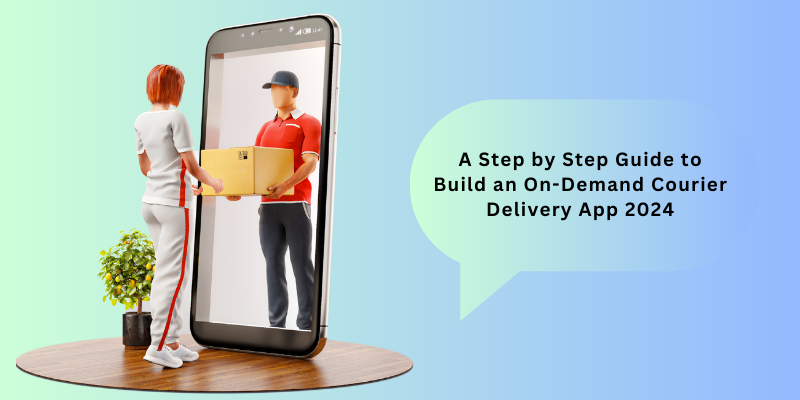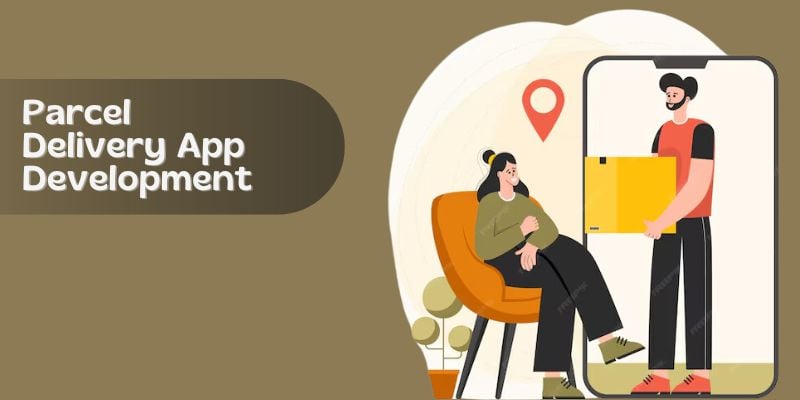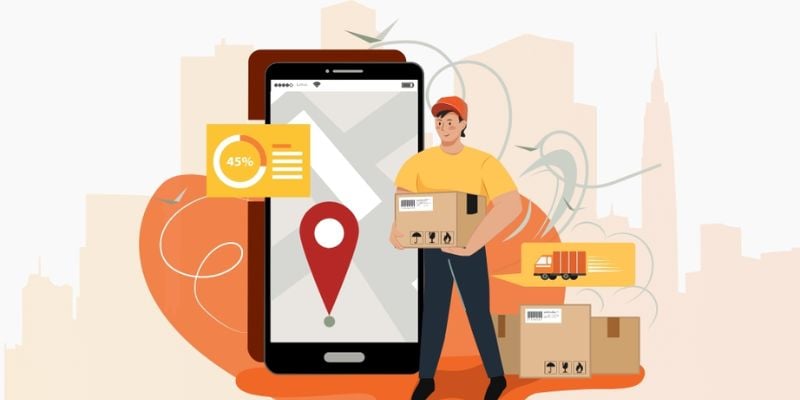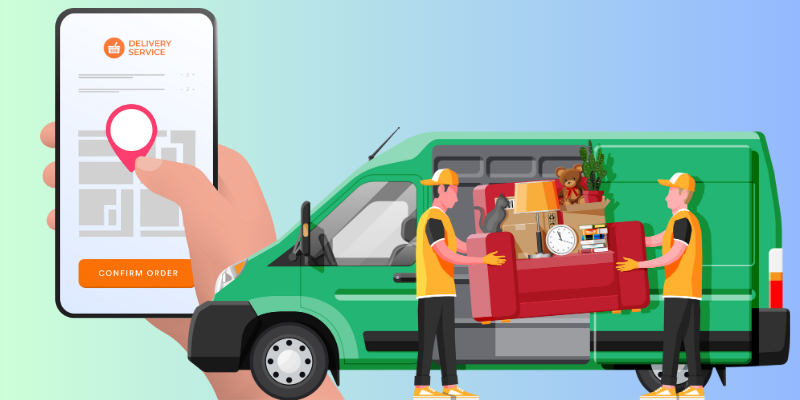The idea of On-demand Courier App Development Solutions has revolutionized consumer comfort and ease. A delivery service on demand has proved to be excellent for customers in various industries, including healthcare, hospitality, and eCommerce. In this age of E-Commerce and online shopping, courier services are essential in ensuring that products are delivered on time to the consumer's doorstep.
The challenges of tracking consignments and delivery of goods are easily solved through an efficient Courier app development. Let's look at the development procedure of an advanced online courier delivery app. The On-demand Courier App DevelopmentSolutions will make your courier service more effective and well-known. But the issue is: How do you create an app that includes all of the features for your courier company?
Interesting Facts and Stats
Statista says the revenue from platform-to-consumer deliveries has risen to $70,000 million. Before the world economy's pandemic, the trade experts forecast the annual growth rate to be 8.2 percent. It's no wonder that people have 24/7 access to an enormous array of goods and services from professionals who are a single click away.
Furthermore, the user base is now at 10%, and the amount users spend on apps is increasing exponentially across different sectors.
In 2026, users of apps like this are predicted to use 143 million applications from the Google Play Store, which is 30 percent more than the amount downloaded in 2021. In relation to the App Store, the number of downloads will be a staggering 38 billion in 2026. This is about 15% more compared to 2021.
Let's dive deeper into the statistics using the graph and points mentioned below:
In 2020, the worldwide app revenues grew by $318 billion. It was over $60 billion (approx.) compared to the previous year.
By 2025, the worldwide revenue of mobile apps is expected to exceed $335 billion.
Of the millions of users worldwide who use mobile apps, more than 50% are regular users of these mobile on-demand applications.
More than 60 percent of customers would be willing to pay an additional amount to get same-day delivery.
You don't know how massive it could be soon because technology is evolving rapidly, and people are becoming immersed in smartphones.
Read Also:Essential Tips for Developing a User-Friendly Courier Delivery App
How to Build Your On-Demand Delivery App
Here are the basic steps you can follow to Courier App Development Solutions quickly and stand out from the crowd:
Validate Your Food Delivery App Idea
Conduct extensive market research before making any decision. However, the delivery market has enormous revenue potential. Only a few significant players -- including DoorDash, Uber Eats, and Grubhub -- control 97% of the market. Be aware that battling these giants is an arduous undertaking.
There is an opportunity for success on a smaller scale. Courier app development to your existing food establishment, grocery store, or even specialty businesses like Ice cream shops. This will allow you to increase your revenue, meet customer expectations, and eliminate costs incurred by third parties associated with other delivery apps.
Choose Your Development Method
There are a variety of ways for Courier app development that delivers meals to your customers:
Using a mobile app developer
DIY with an app creator
Utilizing internal resources
Delegating the development work to a company that develops apps
The third option is less feasible since most businesses do not have internal IT departments.
Identify Your Business Model
Food delivery services operate on different commercial models. Each of these has its way of monetization.
Delivery Service: Your company will manage deliveries between clients and eateries, charging establishments to use your platform and keeping an amount of every order.
The Third-Party Facilitator: Application connects restaurants and customers to third-party facilitators who manage all deliveries. It doesn't directly take part in meal delivery; rather, you provide the application as an additional service.
Fast Food Delivered Directly: Retailers or restaurants have mobile apps that manage order fulfillment internally and bill customers directly.
The first two options generate revenue by charging restaurant owners for delivery, taking a portion of sales, or charging premium subscriptions. The third method directly charges customers or could also charge delivery fees.
Select Your Features
Although all food delivery apps offer a handful of standard attributes, you can alter your application to suit your company's specific needs. Choose your features carefully, as they will guide the complete development process. Be sure that your features are compatible with the principal goal of your application.
If you're establishing a restaurant delivery service, consider putting up a menu system that displays food items above options, like integrating social networks or discussion boards.
Development and Design
The design and development stages can differ depending on the approach you choose. It is easy to design using a DIY app builder, usually starting with pre-designed templates customized to match your brand. Include plugins to perform essential functions like bookings to enhance your food delivery service.
Marketing and Launch
Launching your mobile app on Google Play and Apple App Store is crucial for increasing visibility. Use techniques to increase downloads. Incentives for early downloads, like 20% off the first purchase, could help local businesses adopt the app.
Promote your app via your website, flyers in stores, email marketing, and social media marketing campaigns. Inspire interest prior to the launch date to ensure a large number of users.
In the end, Courier Delivery App Development Services a meticulous strategy. Launching your app in a highly competitive market by confirming your ideas, selecting the most efficient development strategy, establishing your business model, choosing features with care, and executing an effective marketing strategy.
How do you Create a Delivery App that Makes Money?
Let's discuss money. Delivery is profitable and growing rapidly. Take a look at the figures: UberEats generated $10.9 billion in revenue in 2022, and DoorDash revenues for 2023 were $8.15 billion, 34.38 percent higher than in 2022. Sounds good, huh? However, you must first decide on a strategy for monetization prior to launching delivery apps.
Big corporations use a variety of methods of monetization and small-scale food delivery services. We've listed the three most well-known options:
Commission Fee
Many app companies charge eateries a portion to connect them with people who need food. For instance, Uber Eats receives up to 30 percent commission for each order and prohibits restaurants from raising prices to pay for the expenses. A high commission could be fatal for small-scale local eateries, and to stop them from moving elsewhere, we recommend considering everyone's interests to determine a fair cost and then look into different sources of revenue for delivery service.
Delivery Fee
Contrary to the first option, customers pay to deliver their food to their doorstep. Many apps charge a tiny fee ranging from $0.99 for services like Uber Eats or as high as 30% of the total cost, similar to Swiggy. Certain apps have flat rates; others charge fees based on the distance you're from a restaurant and the total price. Despite the steady nature of this kind of income, it's challenging to invest in Courier app development based on this type of model on its own. We suggest using various choices that are most suitable for your needs.
Advertising (or marketing costs)
Advertising is another way delivery apps can earn money. Most of the time, delivery companies work with restaurants to push them to the top spot or promote them on their main page.
Passes
Major players such as Uber or DoorDash recently introduced the latest features. The apps now offer monthly passes at a low cost and include perks like free delivery or additional discounts.
Here's our suggestion for those who are contemplating how to build an application for delivery and be successful: The most important thing is not to stick to one income source and use a variety of monetization strategies.
Read Also: Features of Courier Delivery App Development For 2024
Business Model to Know How It All Works
On-demand courier delivery services are specifically for specific user groups, such as customers and service providers. However, to improve the efficiency of the gig economy and provide the final item or product, developers build applications that can be used by all users involved during the distribution process.
Before understanding how various users contribute to the service, let's look at the different types of apps available on demand.
Business to Consumer (B2C) Apps
B2C Apps are called Aggregate Apps or enterprise-to-person (E2P) software. The B2C category can sell products and services directly from the provider to the individual customer.
The most well-known examples of this type include:
Starbucks, McDonald's, or McDelivery.
Consumer to Consumer App (C2C) Apps
Also called Person, also referred to as Person Person (P2P) application, C2C apps facilitate users to purchase, trade, and exchange products or services with one another.
The most well-known examples that fall under this category include:
Zomato, Munchery and Frichti
Business to Business App (B2B) Apps
B2B, or enterprise-to-enterprise (E2E) applications are designed to connect businesses with companies. They serve as facilitators to deliver services between businesses. They are divided into two divisions, namely vertical (providing services for a single company) in addition to horizontal (providing services to multiple businesses)
Apps such as Cargomatic, Uber for truckers, CaterNation, Emerge, and Eventio are excellent examples of this type of category.
Based on the business model you've selected for developing an app for delivery on demand, the app's stakeholders will be identified. That is, the On-demand Courier App Development Solutionswill develop the apps for each user role.
When your app is B2B, the developers will develop two apps that cater to both companies, respectively. In the same way, if it's B2C, one app would be developed for business, and the other one for consumers. In C2C, both apps will be geared towards consumers.
For instance, Uber Eats operates on a three-tiered strategy for transactions, including B2B (Business to Partner) and B2C.
UberEats collaboration with restaurants, where both businesses are benefited from each other (B2B)
UberEats works with independent delivery companies or drivers who make money through these partners (B2P).
The third category is customers who buy food directly from businesses (B2C).
Technologies Used for On-Demand Delivery App Development
It is essential to select the most appropriate combination of technologies to ensure the efficient and smoothCourier App Development Solutionson demand. This will allow for quick growth and keep costs to a minimum. Let's examine the many technologies required to make an efficient On-demand Courier App Development Solutions.
Client-side (Front-End)
The client side is, in general terms, the app's user interface, which refers to the elements that clients interact with. The top technologies used to build the front-end of a distinct app for iOS, Android, or the web platform are described below:
Swift, Objective-C, and SwiftUI for iOS Respond Native
Kotlin, Java, and React Native for Android; HTML5, CSS, JavaScript, React.js, and Angular.js for the Web.
Using these methods, you can create a user-friendly and visually attractive interface for your On-demand Courier App Development Solutions.
Server-side (Backend)
All the app functions are performed on the backend back end. It communicates with databases and external services, runs business logic, and processes data. Backend development is a process that uses some of the technologies mentioned below are commonly used:
Programming languages: Java, PHP, Python, Ruby (preferred),Elixir.
Frameworks for Web: Phoenix, PostgreSQL, Ruby on Rails (recommended),PostgreSQL (preferred),MySQL
Nginx (recommended) and Apache cloud server platforms are provided through Amazon Web Services (AWS),such as EC2, S3, etc.
Create a secure and scalable backend for your app that delivers on-demand with these tools.
APIs (Application Programming Interfaces) facilitate communication between an app's front-end and backend components. APIs also allow you to integrate external services into the app. APIs define how the different elements of your app interact with each other. RESTful APIs, as well as GraphQL, are two popular techniques for creating APIs.
In the end, the basics: a mix of backend, front-end, and API technologies form the technical stack required to Courier app development on demand. The most efficient technology for each component must be utilized to ensure efficient and speedy development.
Also Read: Comprehensive Guide On Courier Delivery App Development
Cost to Start an On-demand Delivery Business
Many variables, such as the complexity of features, the platforms targeted (iOS, Web),and the hourly rate of the software provider and the features included, can affect the cost of On-demand Courier App Development Solutions. The procedure for estimating the costs of On-demand Courier App Development Solutionsis similar to the method used to calculate the costs of creating other social media or software apps.
For a one-user application, namely a courier or client app, the price of developing a Minimum Demand Product (MDP),which is the first working version of an app for delivery on demand, usually starts at about $50,000 USD per operating system (iOS, Android, or Web).
Thus, starting the first version of a delivery service on demand could cost as little as $20,000 to $60,000 USD.
The sector of on-demand economics offers tremendous investment potential. The impact of COVID-19 and statistics point to an increasing demand for speedy services and products. This industry's $57.6 billion annual spending is predicted to grow as consumer habits shift.
Conclusion
To brief, a good Courier app development could take your courier company up a notch. But just creating an app isn't enough. It would help if you looked at different aspects of growing your business as well as the essential app features that will provide your customers with the top courier services available on demand.
Making an app is only the beginning. In order to consistently draw more users, it is essential to provide high-quality customer service and an easy user experience. The most important thing is quickly responding to your customers' delivery issues. Outsourcing to a reliable tech partner for the Courier app development will ensure prompt completion and release of your application.










